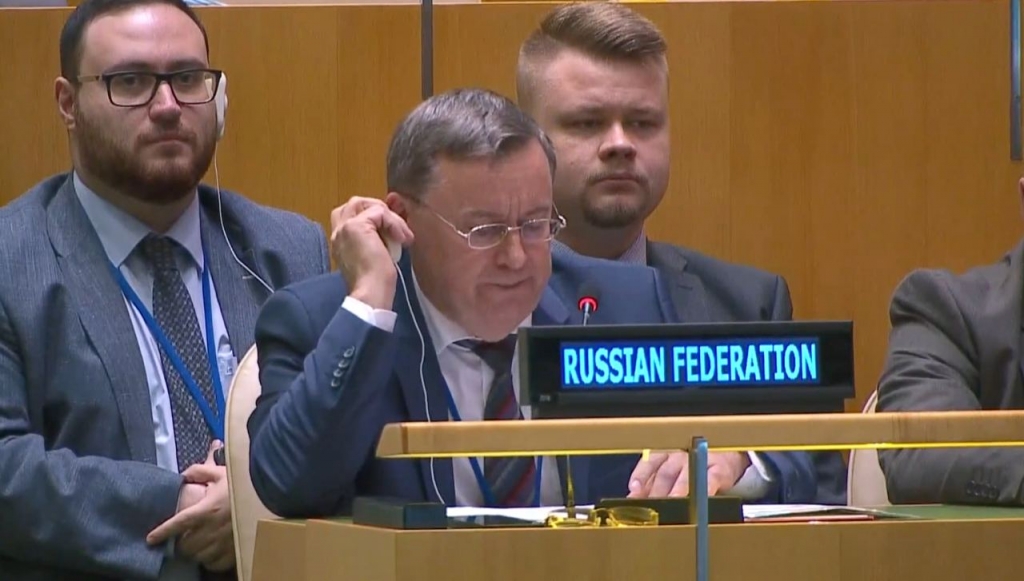Statement by Mr. Igor Vishnevetskii, Deputy Head of the Russian Delegation in Exercise of the Right of Reply at the 6th Plenary Meeting of the 10th NPT Review Conference
Mr.President,
In their statements, certain delegations expressed alleged concerns over the situation around nuclear facilities in Ukraine. They asserted that the reason for this was the presence of the Russian military. As far as we understand, what they referred to was the Chernobyl (Chernobyl NPP) and the Zaporozhye (Zaporozhye NPP) nuclear power plants.
We have repeatedly stated that the activities of our armed forces in no way undermine nuclear safety and security in Ukraine. The Russian military took the Chernobyl and Zaporozhye NPPs under guard to prevent Ukrainian nationalist groups, as well as foreign mercenaries, from using the situation in the country to carry out nuclear provocations which would have catastrophic consequences.
Such risks undoubtedly exist. Allow me to say a few examples.
On 4 March this year, Ukrainian saboteurs began firing from a building on the territory adjacent to the Zaporozhye NPP. After the saboteurs were rebuffed by Russian patrol, they left the building and set it on fire. Western media, at the instigation of the Ukrainian side, presented this incident as the result of shelling by Russian rockets directed at the territory of the plant.
On 9 March this year, the Ukrainian side carried out a provocation by blowing up a power line supplying the cooling system of a storage facility for spent nuclear fuel located on the territory of the Chernobyl NPP. The consequences were promptly addressed: the Russian military connected backup diesel generators, and later the power supply was resumed from the territory of Belarus, since the Ukrainian armed forces were preventing repair work from being carried out. Kiev's propaganda kept silent about these events. We, on the other hand, reported it to the IAEA.
On 27 April this year, the Kiev regime carried out another provocation against the Zaporozhye NPP, sending two unmanned aerial vehicles (UAVs) to the plant, one of which was shot down near the city of Energodar, where the personnel of the station lives. Here is the photo of that incident. The second UAV was shot down in the immediate vicinity of the power plant's perimeter. Both UAVs were identified as Polish-made Warmate air strike systems. The actions of Warsaw can in fact be qualified as abetting to nuclear terrorism.
Most recently, on 18 July, the Ukrainian armed forces once again targeted the Zaporozhye NPP using UAVs. The strike was carried out in the immediate vicinity (a few tens of meters) of the facilities critical to the safety and security of the plant. Only by lucky chance it did not result in damage to the critically important equipment of the Zaporozhye NPP and a technogenic disaster. After that, on 20 July, Ukrainian UAVs struck the Zaporozhye NPP area again, which confirms the intention of the Ukrainian authorities to create prerequisites for a nuclear disaster.
These are just some of the examples that illustrate how the Kiev regime threatens the nuclear security and safety of its own facilities. We regularly report all these facts to the IAEA, disseminating information circulars there. They are available to anyone who wants to read them. We have all the necessary evidence, including photos and videos that can confirm that everything we are saying is the truth.
It should be added that from the very beginning Russia supported the initiative of IAEA Director General Rafael Mariano Grossi to conclude an agreement between the Agency, Russia, and Ukraine to ensure the safety and security of nuclear facilities located in the combat zone. We were ready to sign the document drafted by the Agency and prepared by the Director General. However, the Kiev authorities have disrupted its conclusion.
The Russian military ensured the safety and security at the Chernobyl NPP from 24 February to 31 March this year. They did not interfere with the operation of the plant, and the facility was managed by Ukrainian personnel. Having completed their tasks, the Russian units handed over control of the plant to the Ukrainian side. No claims were made by the station management, which was confirmed by a relevant written agreement.
As for the Zaporozhye NPP, the plant continues to be under the protection of the Russian military. The facility operates as usual, with personnel coming to work as in normal peacetime.
We were ready to assist the IAEA in organizing an international mission of the Agency headed by the Director General to assess the condition of the largest nuclear power plant in Europe and to inventory the nuclear material located there, as stipulated in the safeguards agreement.
We coordinated the timing of the visit (end of June), arranged the complex logistics of the trip, and guaranteed the maximum degree of safety for members of the delegation.
However, just a few days before the planned visit of an IAEA delegation to the plant, the UN Secretariat refused to approve the visit. We are convinced that the cancellation of the international mission of the Agency played into the hands of the Kiev regime and its Western curators who, at the level of representatives of national regulatory bodies and the organization operating the plant, questioned the expediency of the visit to the Zaporozhye NPP while, they say, it remains occupied. We are convinced that Kiev was initially interested in disrupting it in order to prevent the IAEA from making such unfavorable assessments about the fact that the plant was operating in normal mode without any problems.
We reject the unfounded accusations that Russia prevents the Agency's inspectors from visiting the Zaporozhye NPP and, especially, absolutely absurd speculation that a military base is allegedly being set up there. We have yet to hear more absurd propagandistic bogus stories than this.
We are prepared to speak the language of facts and it is up to you to decide where the real rather than fake threat to nuclear facilities is coming from.
Thank you.
